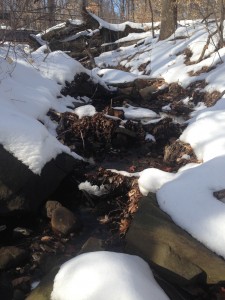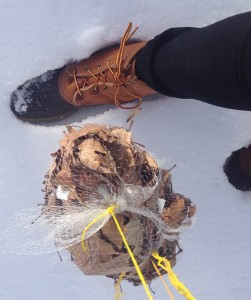Citizen Science: Coaxing Life from Frozen Waters
Posted in Applied Science on March 2, 2015 by Madeline Breda
Madeline Breda is a GreenSchool Science Education Intern at The New York Botanical Garden.

“What is that?”
“What lives in there? Are they dangerous? Do they bite?”
And, loudest of all, “EWWWWWW!”
These are some of the many questions (and noises of disgust) hurled in retaliation to the dripping, mucky leaf pack I hold up at the front of the classroom. Water fresh from the Bronx River streams from the decomposing leaves into a bucket below, and an odor that could be described as either “earthy” or “gross” pervades the GreenSchool classroom. My charges for the next 90 minutes—a group of unsuspecting middle schoolers—want nothing to do with whatever is going on in that mess of organic matter. Little do they know that within minutes they’ll be clamoring to sort through the leaves and rocks and mysterious river sludge to find living treasures underneath…
For the past six months, it has been my job as the GreenSchool Science Education Intern to teach a variety of inquiry-based workshops to visiting school groups of varying ages, ability levels, and interests. Though the majority of GreenSchool’s workshops take full advantage of our massive living museum—the Enid A. Haupt Conservatory—some new programs utilize the Garden’s more rugged resources. During our Citizen Science workshops, students venture into the Thain Family Forest in order to observe the effects of changing seasons, increasing pollution, and global warming on the ecosystems surrounding the Bronx River. Students also get a chance to participate in citizen science—a method of scientific research which engages amateur or nonprofessional scientists in data collection.
These workshops are often revelatory to students who’ve spent most of their childhoods in an urban environment, and who feel that science is a lofty, inaccessible profession, performed only by grownups in sterile white lab coats. “Who knew there was a river in the Bronx!”, and “We have to touch bugs? With our bare hands?” are exclamations I’ve often overheard during my citizen science macroinvertebrate workshops. Students quickly learn that real science is often messy, at times uncomfortable, but always incredibly rewarding.
But before I get too far ahead of myself—what is a leaf pack? Where do they come from? And what exactly lurks within?

In most moving bodies of water, the leaves that fall in tend to accumulate in packs behind branches, rocks, and other obstructions. These accumulations of leaves serve as excellent homes and breeding grounds for macroinvertebrates (insect larvae, crustaceans, etc., all lacking backbones). The macroinvertebrates that live in these naturally-forming leafpacks are often called “canaries of the stream” because they function as living barometers that indicate changes in water quality. Certain macroinvertebrates are more sensitive to changes in pollution concentration than others, so varying numbers of taxa can indicate changing levels of water toxicity.
Ecologists often assemble artificial leaf packs in order to attract these “canaries of the stream” to be counted, measured, and quantified as a method for determining the health of a body of water. These artificial leaf packs are assembled according to a strict protocol—10 grams each of the leaves of the three most common trees near the site are inserted into a mesh bag along with a waterproof identification tag, then tethered to a tree or rock near the edge of the stream. After three or four weeks, leaf packs are removed from the stream to be “dissected” by willing citizen scientists.
In preparation for some citizen science workshops coming up in March, I trekked through the snow into the Thain Family Forest toting leaf packs, string, and a hefty pair of waterproof boots. Once installed in the tributary stream leading down to the Bronx River, the leafpacks will attract hardy insects and crustaceans with promises of food, shelter, and room to reproduce. But only time will tell what might emerge from the close-to-frozen waters when my classes come in mid-March. Will runoff from melting snow bring higher levels of pollution into the stream, discouraging macroinvertebrate visitors? Will a harsh February affect the diversity of taxa within the leafpack? Tune in during mid-March to find out!


Dear Madeline,
This was indeed a wonderful piece: interesting, vivid, and so well written. I look forward to many more!